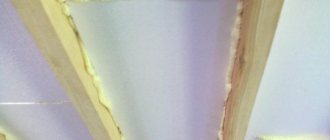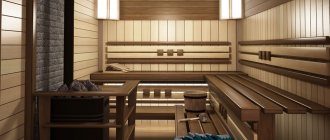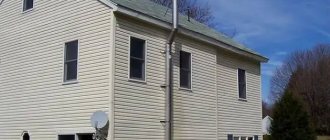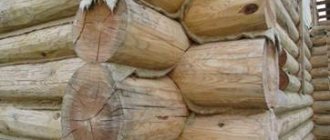Houses made of timber have a lot of features that distinguish them from buildings made of other materials. One of them is that after construction is completed, the house begins to dry out. This process is inevitably accompanied by a change in shape and the appearance of gaps between the crowns. These openings allow cold air from outside to enter, which forms condensation when it meets warm air from inside the house. As a result, mold and even rot can occur in the premises.
Shrinkage is a natural process and therefore cannot be prevented. Even logs and beams that have been dried according to all the rules will certainly shrink. The only thing that remains for the owner is to fight the formation of cracks. It is for this purpose that caulking is carried out - a necessary procedure during which the gaps that arise between logs or beams are manually sealed.
Why do you need to caulk a log house?
The process of caulking is the insulation of a log house by sealing the cracks between adjacent logs. Most often, log houses are used as bathhouses, and so that the steam room warms up faster and you can wash in it even in winter, it needs to be properly caulked.
During caulking, a compactor is placed between the logs Source koon.ru
Here are the main problems that log caulking helps solve:
- Presence of gaps between individual logs
- The appearance of drafts and condensation
- Rotting and premature destruction of wood
In addition, if we talk about a bathhouse, then less fuel will be required to heat a caulked room.
Why do you need to insulate the seams?
When building housing from wooden beams, insulation is laid on each crown. But over time, the house shrinks by 5-10 cm, the linen or jute tape moves, and gaps appear. This leads to the appearance of cold bridges.
To increase the thermal capacity of the building, be sure to caulk all joints and cracks. This procedure allows you to avoid the appearance of frost on wooden surfaces , which is fraught with cracking of the wood and the occurrence of high humidity.
Thanks to caulking, the microclimate of the house becomes more favorable, and heating costs are reduced.
If the humidity of the beams is high, mold may appear and rot may spread. This will affect the health of the people living in the house.
Lack of timely caulking will lead to the following problems::
the homeowner will be forced, figuratively speaking, to “flood the street”;- the wood will rot and turn black due to dampness;
- the performance characteristics of profiled or laminated timber (heat capacity, strength) will deteriorate;
- There will be a distortion of the walls due to the unevenness of the insulation between the crowns.
In addition, there will be sections of walls that are periodically subject to icing. Through them, the heat will quickly leave the house.
Even if the outside walls are finished with siding with a windproof membrane, the building still needs periodic caulking.
Beams for a country building can be selected from different batches, differing in operating conditions, shrinkage period and other characteristics. This will affect the deformation of the walls, lead to the appearance of cracks and, again, lead to the issue of insulation.
How can you caulk a log house?
There are a wide range of options for caulking a log house. Each material has its own characteristics, its own strengths and weaknesses, but they all meet the general requirements for insulation: they retain heat well, do not emit harmful substances, and retain their properties for a long time.
Below we provide a list of the most popular materials for log caulking.
Jute for log caulking
Jute is highly durable and does not absorb moisture. It is made from natural ingredients. Jute provides an excellent level of thermal insulation for a room.
Jute is a natural material for caulking log houses Source 2gis.ru
There are three forms in which intercrown jute is produced:
- Jute tow is a tough but loose material, inconvenient because it needs to be caulked several times.
- Jute felt is a fairly dense and at the same time flexible insulation material. However, insects often live in it. Therefore, before caulking, the material must be treated against parasites.
- Jute flax is very similar in appearance and properties to flax wool.
We caulk the log house with tow
Tow is very often used for caulking. It can be made of hemp, jute or flax. Provides good thermal insulation of the room. However, tow is susceptible to rotting. Insulating a log house with this material is not an easy task, because it is quite difficult to install it in the cracks between the logs.
Caulking a log frame with tow requires patience and diligence Source blog.leskos.ru
Tow is the cheapest insulation option. But in terms of its performance qualities it is inferior to other materials. When the log house dries out, tow quickly begins to rot and crumble into dust. Therefore, after a few years the caulking process will have to be repeated. It is believed that the service life of tow is 3 years. After this, it is recommended to replace it.
See also: Catalog of bathhouse projects
Caulk of a log house with moss
Moss is a material that has been used for caulking log houses for many centuries. He has his strengths. For example, an antibacterial substance of natural origin, thanks to which microorganisms do not multiply in moss. This insulation also provides a high level of thermal insulation.
But there are nuances. If you use moss that is too wet, the wood will soon begin to rot. Overdried material will crumble. This is despite the fact that before use the moss is thoroughly soaked and then dried in the sun. In addition, the price of moss for caulking is quite high.
Moss is a traditional material for caulking log houses Source elka-palka.ru
Those who are wondering how to properly caulk a bathhouse with their own hands should take into account that working with moss is a complex procedure that requires experience. The moss must be placed correctly, otherwise it will not give the desired effect.
Linen batting: is it suitable for caulking?
Linen batting is a material made from flax fibers. It has good thermal insulation properties and is completely environmentally friendly. The strength of flax wool is that it is able to absorb and release moisture when there are changes in air humidity. This prevents wood from rotting.
However, flax wool does not last long - up to three years. Insects quickly infest it, so it needs to be treated once a year. And if we are talking about a bath, then such treatment will not benefit the atmosphere in the steam room. Linen batting is very similar to jute, but it is stiffer and stronger.
When caulking a log house, flax batting is secured with a construction stapler Source bg.decorexpro.com
See also: Catalog of companies that specialize in the construction and finishing of baths
Is it possible to caulk with sealants?
Before caulking a bathhouse, you should pay attention to a material such as synthetic sealant. It is easy and convenient to use, and it does not leave any cracks or gaps. The compositions have different colors, so it is easy to choose a sealant for a specific type of wood.
Often sealants are used in combination with other caulking materials. For example, with jute or linen. Using the composition you can create an even layer of insulation. This material is sold in the form of pipes or briquettes. This method does not require re-caulking the log house even after a long period of time.
Sealant is a modern solution for caulking log houses Source yandex.fr
The sealant is only suitable for caulking log houses made of rounded logs. Moreover, the grooves in it should have a semicircular shape. Otherwise he won't be able to grab it.
Caulking tools
If natural materials are used for thermal insulation of a wooden house, then before caulking you should prepare:
- Kiyanku. A small wooden or rubber hammer designed for laying insulation using wooden caulks.
- Stacked caulk. A spatula with a metal or wooden base, blade width 10 cm, thickness 0.5 cm. This is the main tool for caulking the crowns of a log house.
- Crooked caulk. A curved chisel with a flat blade 5 cm wide and 0.5 cm thick. Used for filling corner seams and gaps in rounded areas of the building with insulation.
- Road worker. Triangular blade with a special longitudinal groove. The blade width is 17 cm, thickness is from 0.8 to 1.5 cm. The tool is intended for filling gaps of equal width.
- Breaking caulk. A narrowed wedge-shaped blade up to 3.5 cm wide, which allows you to widen the inter-crown gaps for the convenience of laying heat-insulating material.
Important! All caulking blades should be slightly dull and smooth to avoid damaging the wood and pulling the insulation out of the seams. Before starting work, the tools are thoroughly cleaned with a clean cloth.
How to properly caulk a log house: methods, recommendations
There are two main methods of caulking: set and stretched.
First, about how to caulk the set. This method is suitable when the gaps between the logs are too wide. The material is twisted into a ball, and then, gradually unrolling it, it is driven into the inter-crown space. Where the gap widens, the strip is folded into a loop and hammered in two layers. Moreover, the caulk should be started from the top of the gap.
This is how log houses are caulked into a set Source kamrtn.ru
Which is better to choose?
- Moss is the most environmentally friendly and durable material, but it is very difficult to obtain, to ensure compliance with installation technology and the need to maintain optimal moisture content of the insulation, since it crumbles when it dries out. Requires skilled work. Therefore, using moss will be the best solution if you have good caulkers.
- Linen tow is less strong and durable, and has low performance characteristics. Not suitable for timber walls due to high hygroscopicity.
- Hemp hemp is the best option, but is difficult to obtain. Natural jute is a good material, but has a short shelf life. Its advantage is density - 300-400 g/sq.m. m.
- Jute is the best insulation for a house made of profiled timber. It has a high density, and a layer of 3-4 mm is enough to lay it. If jute is not suitable for some reason, linen felt 5-10 mm thick will be an excellent solution for insulation.
Video description
This video describes in detail the methods of caulking log houses:
They try to use wooden tools for caulking log houses. They are softer and do not leave damage on the logs.
It is advisable to caulk the log house from the inside and outside. You need to start from the corners, you need to go from bottom to top, caulking each row to the end. If you work on the walls separately, you can warp the entire building.
You need to start caulking the log house from the bottom rows Source psk.baraholka.com.ru
Execution of work
Caulking of log houses or beams is a labor-intensive task that is performed entirely by hand. There are no devices that mechanize such work. This process is long and quite difficult; the master performs it only with his own hands.
Caulkers are a special specialty in wood construction. The caulking team consists of several physically resilient and strong men who perform caulking exclusively.
Since these masters are not involved in other types of work, they reach the pinnacle of mastery in their specialization and have the highest qualifications. If possible, you should definitely use the services of such a team, since everything is done quickly and with the highest quality.
It is quite clear that a team of caulkers has at its disposal the entire necessary set of tools to carry out caulking of a log house of any complexity:
- in the presence of any material for sealing the seams of the log house;
- different sizes of seams;
- different types of wood for wooden buildings;
- the need to seal seams in complex elements.
Every stage of work is important. It is impossible to neglect caulking, on which the warmth and comfort of living in the house depends. It is impossible to do without it in wooden construction.
How to caulk a log house with various materials
To finally decide how to caulk a log house, it is worth studying the technology of working with various materials. Let's start with moss.
Dry fibers cannot be laid. Before caulking, they are moistened and dried. Moreover, it is necessary to prepare a special solution. It will require a bucket of water, half a liter of vegetable oil and 200 g of soap.
Then the moss is laid out into strips 10-15 cm wide, the ends of these strips are twisted upward. It turns out to be a roller that needs to be placed in the gap and hammered in with a spatula and mallet.
The moss needs to be tightly driven into the gaps so that the edges do not stick out Source winterhouse.ru
When is caulking done?
Caulking a wooden house is carried out in several stages, and this is explained by the gradual shrinkage of the wood. Maximum shrinkage occurs during the first 18 months after completion of construction work and stops after 5 years.
- The first stage of caulking is performed after assembling the log structure. In this case, when building a house, thermal insulation material fills the space between the logs so that the edges hang freely on both sides. After installing the roof structure, the insulation is driven into the connecting seams between the crowns.
- The second stage of insulation is carried out 1.5 years after the completion of construction work and preliminary shrinkage of the house. The insulating material is laid tightly enough to hide all the gaps and cracks.
- The third stage of caulking is carried out after 5 years, when the process of shrinkage of the log house is considered completely completed. All existing defects between the logs are filled with insulation.
Important! For a log house, all three caulking steps are carried out, but for a house made of timber, which will be lined with siding on the outside, the third stage of caulking is optional.
Video description
Watch a video on how to caulk a log house with jute:
And the last thing we will look at is caulking a log house with sealant. A sealing cord is first laid in the gap, and then the entire gap is blown out with foam from a mounting gun. You can also seal large cracks in logs.
Then the seams that have not yet dried are moistened with water and carefully smoothed with a brush or spatula. All excess foam is removed.
The easiest way to caulk a log house with sealant is Source krasiviy-dom.ru
Quality checking
Many owners of log houses hire construction crews to carry out such work. In this case, you need to know how to check the quality of the seams between the crowns.
You can use two methods:
You should try pushing a regular awl or knife into the seams. If it barely penetrates to a length of 15 cm and is not visible from the opposite side, the caulk is made with high quality.- You can also try pushing the caulk between the seams yourself using a mallet. Usually it rests on a dense layer of insulation.
The best option not to make a mistake is to choose a knowledgeable person who will take responsibility for monitoring the work.
Then we can hope that the builders will not “crash” and the caulking will be carried out according to all the rules.
Briefly about the main thing
Log houses need to be caulked so that they are not blown in from the street and retain heat well. This is especially true for bathhouses and residential buildings.
For caulking log houses, natural materials are used, such as jute, flax, tow or dried moss.
The easiest caulking material to use is construction sealant.
There are two main ways to caulk log houses - in a set and in a stretch.
Moss must be moistened before laying in the cracks. Tow needs to be treated with formaldehyde solution.
After you have sealed the cracks between the logs with sealant, you should smooth out the seams and remove excess foam.
Ratings 0
Caulking corners
The corners in the log house are insulated after the main work is completed.
To do this, it is better to use rolled insulation and curved caulk. The process works as follows:
- The free edge of the tape insulation is applied to the seam located in the corner and filled with crooked caulk.
- After installing the material, its free edges are rolled up and hammered into the seam.
- All work on laying insulation is carried out from top to bottom. To ensure uniform driving, the material is carefully stretched and straightened.
Types of tow
There are two types of tow: beige and brown. But they differ not only in color, but in parameters and purpose.
Beige
The color itself indicates the naturalness of the composition without chemical additives. This environmentally friendly and safe material is sold in almost all stores. This tow is mainly used for caulking.
Small bundles are rolled out of it, which are inserted into the interventional seams with a special tool. It is recommended to caulk twice: directly during the laying of the walls and after a year.
Brown
Such fiber is usually used as a sealant during the installation of pipeline systems. It helps to quickly eliminate leakage from the pipe, without requiring the dismantling of too many parts and joints.
Brown fiber is impregnated with special means, thanks to which it becomes an ideal material for arranging heating and water supply systems.
Approximate costs
The cost of the work of craftsmen, regardless of the type of insulation material, is on average in the Russian Federation - 45 rubles per 1 sq. m. m, there are prices for 1 linear meter in the Moscow region - 65–70 rubles.
Removing old tow will cost about 30 rubles. for 1 m.
At the same time, the average prices for insulation materials in the Russian Federation:
- Jute tape - 9–16 rubles/1 linear line. m.
- Linen wool - 5–7 rubles/linear. m.
- Jute tow - 135 rubles/kg.
- Hemp hemp - 100 rubles/kg.
- Linen tow - 75 rubles/kg.
- Moss - 300 rubles/45 liter bag.
The final touch - sanding
Caulking has not yet completed the construction of the log house until it is ready for flooring, installation of the attic floor, roof, installation of windows, doors, partitions, for finishing and equipment - it is desirable to sand the log house, but it is necessary to sand the inside. Especially - chopped from wild logs, debarked by hand.
Sanding a frame with sandpaper is extremely time-consuming, tedious, and this damages the outer most resistant layers of the wood. The frame is sanded using a hand-held universal grinder with nylon brushes. Worse - grinder with them; drive is too powerful. But the main thing here is still brushes for sanding wood, see video review:
Video: review of nylon brushes for sanding logs
Sanding a log frame with a brush is actually a controversial issue: the brush removes the bead of caulk, see fig.:
Sanding a log frame with a nylon brush
It is definitely clear that it is better not to touch the outside of the log house with a brush. However, there is a way to polish the outside of a log house - this is abrasive blasting. The abrasive used is... baking soda, which does not harm either the wood or the caulk. Of course, during your work you must observe all the safety precautions necessary for abrasive blasting. But the process itself can be carried out with a homemade sandblasting machine (sandblasting), because soft abrasive powder is used, see video:
Sale of tow
You can buy it in a roll or bale. A bale is a compressed bale of large volume, and a roll is a strip, usually 15 cm wide and 50 to 80 meters long.
When rolled tow is used, the seams are filled more evenly due to the ability of its smooth compression or stretching.











